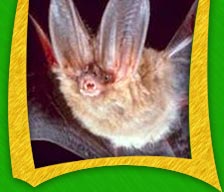|
GOING BATTY
There are an estimated 1,100 species
of bats worldwide, accounting for about 20% of all mammal species.
About 13 species of bats call Florida home. Bats can be seen during
the evening hours usually around bodies of water, forest edges,
along buildings and around light. During the day they seek shelter
in dark, secluded places. These ‘roosts’ can be found
in buildings, caves, crevices and even tree branches.
Bats eat a variety of foods including: fish, mice, lizards, insects,
blood, fruit and nectar. All of the bats residing in Florida eat
insects. Some bats use echolocation in addition to their other
senses to capture their prey in complete darkness. They can capture
small prey in mid-flight, while landing for larger prey. Because
most species of bats eat insects, they are considered the best
natural controller of insect populations.
|
 Colony of the Mouse-eared bat
Colony of the Mouse-eared bat
Photo taken in Walchsee, Tirol, Austria |
COME FLY WITH ME
Contrary to
popular opinion bats are not flying rodents, but belong to the
order Chrioptera which is Latin for ‘hand wing’.
The wings of bats are actually modified forelimbs. The bones of
the hand and fingers are elongated and a membrane stretches between
the fingers, hand and body. This serves to support and move the
wing while in flight. The hind limbs of bats are modified as well
for landing and hanging upside-down.
BATS AND DISEASE
Because
bats travel long distances, live in large social groups and have
close evolutionary ties to humans these creatures are susceptible
to carrying many diseases that can be passed on to humans. These
diseases include: rabies, SARS, West Nile virus and possibly ebola
virus. Most bats have a high tolerance for carrying these diseases
and often do not suffer any ill effects.
While many
people associate bats with the spread of rabies, only about
0.5% of bats actually carry rabies. Most of the U.S. cases of
rabies reported each year are caused by bat bites. One sign that
a bat may have rabies is behavior; they may seem disoriented or
clumsy, possibly even unable to fly.
Bats are amazing creatures
that stir up a lot of curiosity. However, as with any wild animal,
precaution and respect are very important. Even
though the chance of infection is slim, bats should never be handled
by anyone who is not a trained professional.
Resources for this article
have been provided by Wikipedia and
the Bat Conservation
International
|







